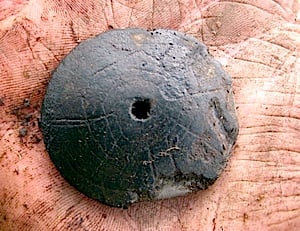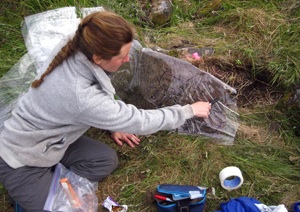A curious set of prehistoric clay disks has been discovered in Noatak National Preserve in northwestern Alaska, leading archaeologists to believe they've encountered a new aspect of the region's past.
The team was led by Scott Shirar, a research archaeologist with the University of Alaska Museum of the North. They headed to Noatak this summer to investigate an area where petroglyph-marked boulders and the remains of several prehistoric dwellings were discovered along Feniak Lake back in the 1960s and 1970s.
When the archaeologists made some small digs at the site, they came upon the four disks.
“The first one looks like a little stone that had some scratch marks on it,” said Mr. Shirar in a release from the university. “We got really excited when we found the second one with the drilled hole and the more complicated etchings on it. That’s when we realized we had something unique.”

This is one of four clay disks found at Noatak National Preserve in northwestern Alaska. Photo by Scott Shirar, University of Alaska Museum of the North.
Questions remaining to be answered, though, range from the purpose of the disks to their age. For now the assumption is that the site was occupied in the late prehistoric era, or roughly during the last 1,000 years, according to the release.
“We only opened up a really small amount of ground at the site," said Mr. Shirar, "so the fact that we found four of these artifacts indicates there are probably more and that something really significant is happening.”
Mr. Shirar said the precise meaning of these petroglyphs, as well as the designs on the clay disks, is still unknown, but their value is clear.
“These objects and places clearly had special significance to their makers," he said. "These finds offer an especially tangible reminder of the rich spiritual and intellectual lives they led.”

Mareca Guthrie accompanied the archaeologists to make tracings of petrolyphs found on boulders. Photo by Scott Shirar, University of Alaska Museum of the North.
The crew visited the site to document the rock art, and to excavate the subterranean house pits to find samples for radiocarbon dating, such as animal bones or other organic matter that will give scientists a better idea of when people lived there.
The release went on to say that while prehistoric rock art is common in places such as the American Southwest, "it is exceptionally rare in Interior and Northern Alaska."
While on-site, Mr. Shirar's team worked to document the petroglyphs found on boulders there. Mareca Guthrie, the fine arts collection manager at the University of Alaska Museum of the North, joined the expedition to make sketches and take tracings of the boulders. Once on site, she quickly developed an appreciation for the people who had lived there.
“It felt so intimate to be looking through someone else’s things, knowing that they sat in the same spot and saw the same view of the mountains. When I started getting tired of the mixed nuts I brought for lunch, I thought, ‘Did the kids complain when they ate caribou day after day or were they thankful to have it?’” she was quoted as saying.
“I became so hungry to know more about them, I’m afraid I may have driven the archeologists a little crazy with my questions.”


 Support Essential Coverage of Essential Places
Support Essential Coverage of Essential Places







Comments
What a remarkable discovery. I hope further excavation will reveal more. My curiosity ius whet with anticipation.
I have seen objects from eastern europe, similar to the discs they found, that were dated to around 7,000 to 5,000 years ago and were described as "loom weights". They even had similar markings on them. It will be interesting to see if there are more discs and what they might have been used for.
Amazing find. I have read Barry Fell's books (written in the 70's) regarding petroglyphs and travelers to North America from places abroad (especially he was interested in celtic, phoenician, libyans) and this reminds me of that. These finds clearly seem to be from some ancient culture likely very different. Fascinating.ei
looks simialar to message stones found in cape krusenstern